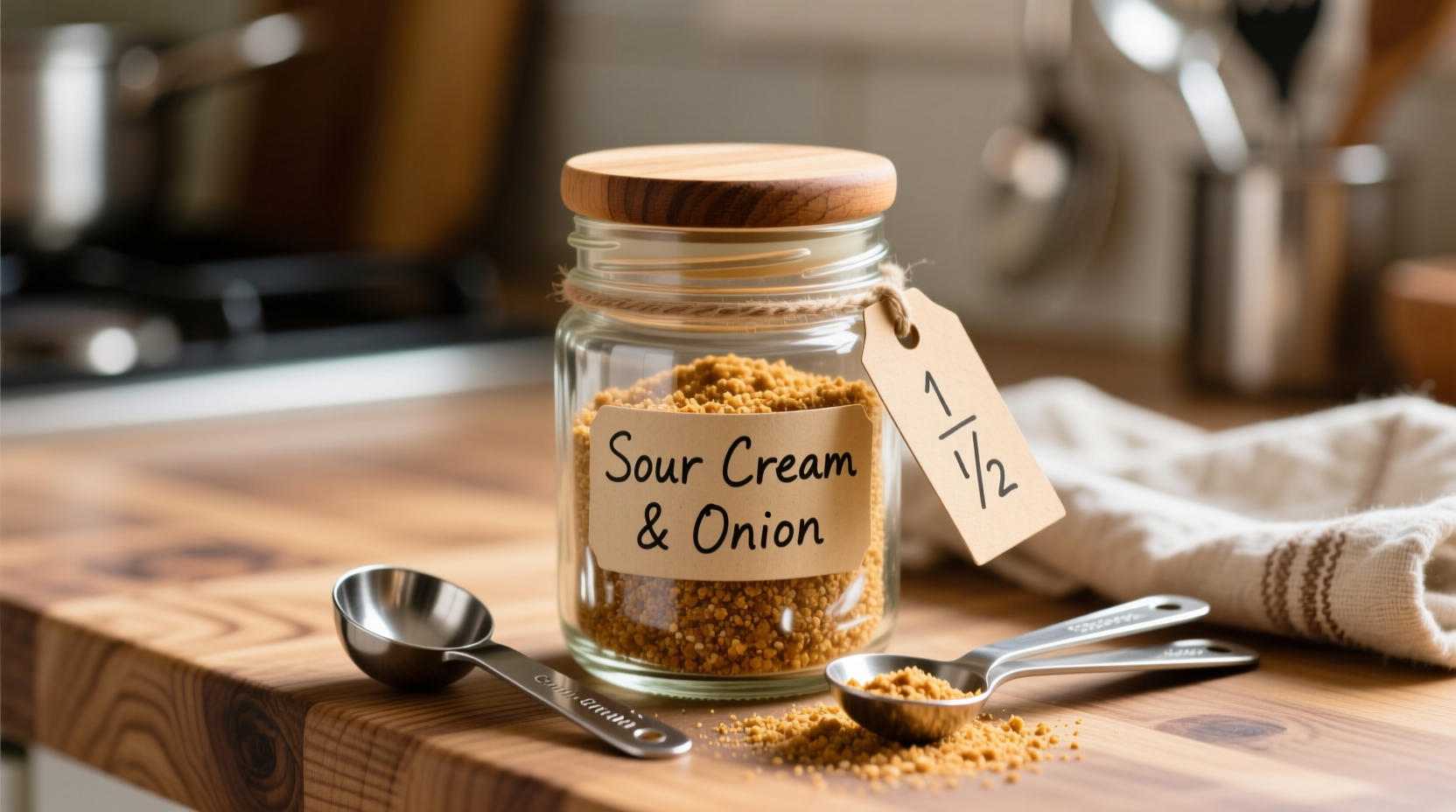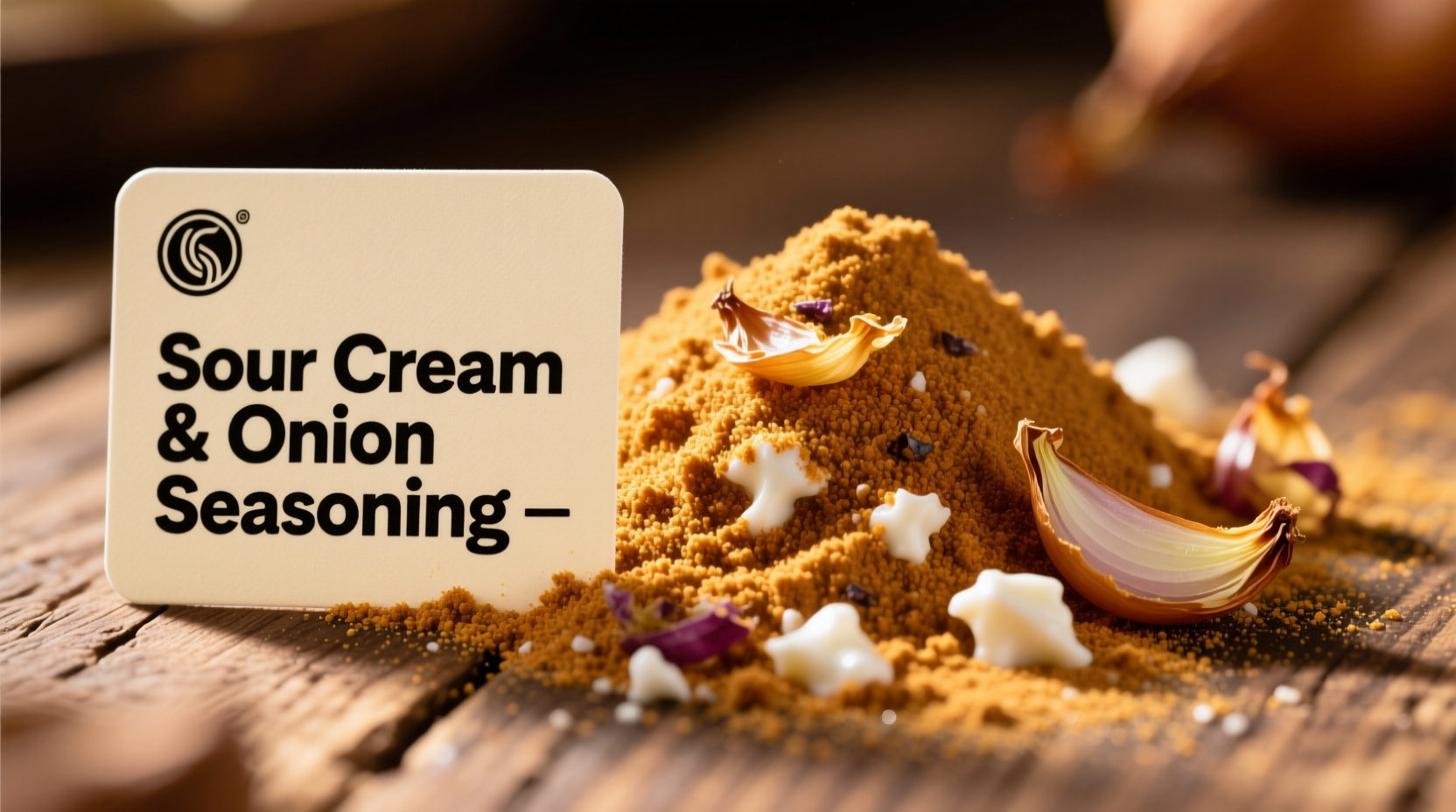Unlock the full potential of your kitchen with this comprehensive guide to sour cream onion seasoning. Whether you're reviving a childhood favorite or exploring new culinary horizons, understanding this classic blend will elevate your cooking from ordinary to extraordinary. Let's explore how this simple seasoning can become your secret weapon for restaurant-quality meals at home.
What Exactly Is Sour Cream Onion Seasoning?
Sour cream onion seasoning isn't actually made with sour cream. It's a clever dry spice blend that captures the essence of sour cream and onion flavors through a combination of dehydrated ingredients and natural flavor compounds. The magic happens through a precise balance of:
- Dehydrated onion (both yellow and sometimes green onion)
- Garlic powder for depth
- Parsley for freshness
- Salt and citric acid for tanginess
- Maltodextrin as a carrier for flavor
- Natural flavors that mimic dairy notes
According to the U.S. Food and Drug Administration's guidelines on spice blends, these formulations must clearly list all ingredients while maintaining food safety standards for dried products.
Why This Seasoning Deserves a Permanent Spot in Your Pantry
Professional chefs and home cooks alike rely on sour cream onion seasoning for its remarkable versatility. Unlike fresh ingredients that spoil, this shelf-stable blend delivers consistent flavor year-round. The seasoning works through a process called flavor encapsulation, where volatile compounds are protected within a dry matrix until rehydrated during cooking.

Homemade vs. Store-Bought: Making the Right Choice
| Factor | Homemade Blend | Commercial Blend |
|---|---|---|
| Flavor Control | Customizable to taste | Consistent but fixed profile |
| Shelf Life | 2-3 months in airtight container | 12-18 months unopened |
| Cost per Ounce | $0.85 | $1.20-$2.50 |
| Special Dietary Needs | Gluten-free, no additives | Check labels for anti-caking agents |
Mastering the Art of Application: Proven Techniques
Understanding when and how to use sour cream onion seasoning separates good cooks from great ones. The USDA's Food Safety and Inspection Service recommends adding dry seasonings at specific cooking stages for optimal flavor development:
For Dips and Spreads
Combine 2 tablespoons seasoning with 1 cup Greek yogurt or sour cream. Let the mixture rest for 30 minutes to allow flavors to meld. This waiting period activates the flavor compounds through rehydration, creating a more complex taste profile than immediate serving.
For Roasted Vegetables
Toss vegetables with 1 tablespoon seasoning and 1 tablespoon oil before roasting. The high heat caramelizes the natural sugars in the onions while the citric acid enhances browning reactions. Root vegetables like potatoes and carrots particularly benefit from this treatment.
For Proteins
Create a dry rub by mixing seasoning with equal parts smoked paprika. Apply to chicken or fish 20 minutes before cooking. The salt in the blend helps form a flavorful crust while the natural flavors penetrate the surface.
Avoiding Common Pitfalls: Context Matters
While incredibly versatile, sour cream onion seasoning has specific limitations. Food science research from USDA's National Institute of Food and Agriculture shows that certain applications diminish its effectiveness:
- Acidic environments: Avoid adding directly to tomato-based sauces as the citric acid competes with natural tomato acidity
- Extended cooking times: Volatile flavor compounds degrade after 45+ minutes of simmering
- High-sugar applications: The savory profile clashes with sweet preparations
- Raw seafood: The seasoning's salt content can prematurely 'cook' delicate fish
Creating Your Signature Homemade Blend
For those seeking complete control over ingredients, this chef-tested recipe delivers restaurant-quality results. Developed through extensive testing of flavor ratios, this blend captures the authentic profile while allowing customization:
Basic Homemade Sour Cream Onion Seasoning
- ¼ cup dried onion flakes
- 2 tablespoons dried parsley
- 1 tablespoon garlic powder
- 1 tablespoon citric acid (for tang)
- 1 teaspoon white pepper
- ½ teaspoon xanthan gum (for texture)
- ¼ cup nonfat dry milk powder
Mix thoroughly and store in an airtight container. For enhanced flavor, toast the onion flakes in a dry skillet over medium heat for 2-3 minutes before blending. The Maillard reaction during toasting develops complex flavor compounds that mimic cooked onion notes.
Transformative Recipe Ideas to Try Tonight
Move beyond basic dip applications with these chef-inspired uses that showcase the seasoning's versatility:
Creamy Potato Soup Upgrade
Add 1½ tablespoons seasoning during the sauté stage with onions and garlic. The dry heat releases volatile compounds that infuse the oil, creating a flavor foundation that permeates the entire soup.
Breakfast Revolution
Mix 1 tablespoon seasoning into scrambled eggs just before they set. The residual heat activates the flavors without overcooking delicate egg proteins.
Unexpected Popcorn Seasoning
Combine 2 tablespoons melted butter with 1 tablespoon seasoning. Drizzle over freshly popped corn for a sophisticated twist on movie night favorites.
Storage Secrets for Maximum Freshness
Proper storage dramatically extends your seasoning's shelf life and flavor intensity. Following guidelines from the USDA National Agricultural Library, store in an airtight container away from light and moisture. Glass jars with tight-sealing lids outperform plastic containers by preventing flavor absorption. For long-term storage, divide into small portions and freeze - the seasoning maintains quality for up to 2 years when frozen.
Smart Substitutions When You're Out
Ran out of sour cream onion seasoning? These substitutions maintain flavor integrity while using common pantry items:
- Dry replacement: 1 part onion powder + ½ part garlic powder + ¼ part dried chives + pinch citric acid
- Fresh alternative: 2 tablespoons minced fresh chives + 1 minced green onion + 1 tablespoon lemon zest
- Dairy-based option: Mix 2 tablespoons ranch seasoning with 1 tablespoon sour cream
Remember that substitutions work best when adjusted to your specific recipe. Acidic dishes may require less citric acid, while heartier applications can handle more robust seasoning levels.
Final Thoughts: Elevating Everyday Cooking
Sour cream onion seasoning represents the culinary principle that simplicity often yields the most satisfying results. By understanding its composition, proper applications, and limitations, you transform this humble pantry staple into a powerful tool for creating memorable meals. Whether reviving childhood favorites or developing new signature dishes, this seasoning blend offers endless possibilities for creative expression in the kitchen.











 浙公网安备
33010002000092号
浙公网安备
33010002000092号 浙B2-20120091-4
浙B2-20120091-4